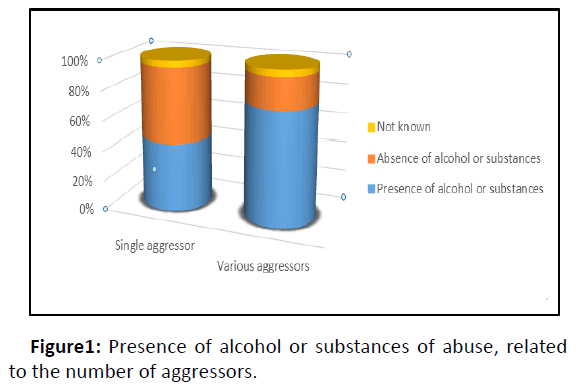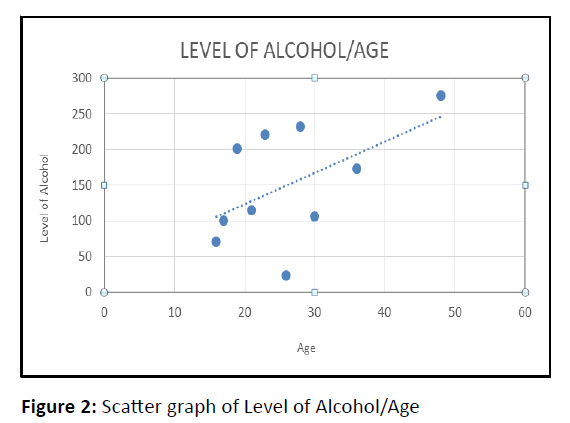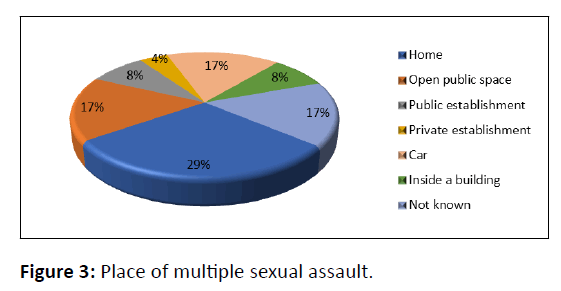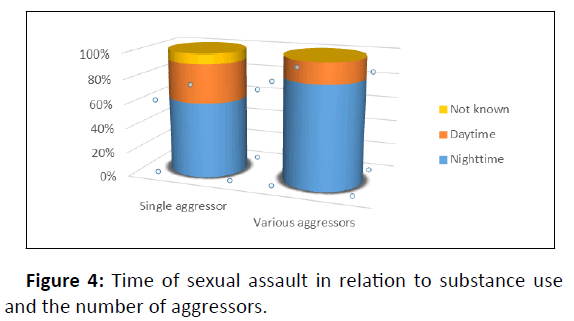Analysis of Vulnerability Factors in Victims of Multiple Sexual Assault
Jorge González-Santamartina1 , María del Carmen Salvador Martínez2 and Jorge González-Fernández3*
1Department of Coroner, Institute of Legal Medicine and Forensic Sciences, Asturias, Spain
2Department of Coroner, Institute of Legal Medicine and Forensic Sciences, Valencia, Spain
3Department of Coroner, Institute of Legal Medicine and Forensic Sciences, La Rioja, Spain
- *Corresponding Author:
- Jorge Gonzalez Fernandez
Department of Coroner,
Institute of Legal Medicine and Forensic Sciences, La Rioja,
Spain,
E-mail: jgonzalezf@larioja.org
Received date: August 16, 2022, Manuscript No. IPJMTCM-22-14450; Editor assigned date: August 19, 2022, PreQC No. IPJMTCM-22-14450 (PQ); Reviewed date: August 29, 2022, QC No. IPJMTCM-22-14450; Revised date: September 08, 2022, Manuscript No. IPJMTCM-22-14450(R); Published date: September 23, 2022, DOI: 10.36648/2471-641.8.5.28
Citation: Gonzalez-Santamartina J, Martínez-Salvador MC, Gonzalez-Fernandez J (20 22) Analysis of Vulnerability Factors In Victims of Multiple Sexual Assault. J Med Toxicol Clin Forensic Vol.8 No.5: 28
Abstract
Group sexual violence against women is a criminal phenomenon that has acquired great social relevance in Spain from the so-called "Trial of The Pack", for the assault on a young woman who was abused at the San Fermin Festival in 2016.
Despite this, there are hardly any studies on this type of violence, which requires further research aimed at identifying vulnerability factors in potential victims of these attacks.
In a sample of 202 cases of female victims over 12 years of age, evaluated by professionals from the Institute of Legal Medicine and Forensic Sciences of La Rioja between the years 2009-2020, group aggressions were recorded in 10.9%of the cases (n=24), with 2 out of 3 being perpetrated by two aggressors (n=16).
The presence of toxic substances or alcohol is also studied, the places in which this type of violence against women most often takes place and the times in which it occurs, establishing that in 75% of the cases there are substances mostly alcohol that facilitate sexual assault, that this type of violence most often takes place in private homes (29%) and that it occurs at night (79.1%). Finally, the previous relationship of the victim with her aggressors is analyzed, resulting in 50% of the cases being acquaintances and for the most part with a bond of friendship.
Keywords
Sexual violence; Multiple sexual assault; Chemical submission; Alcohol
Introduction
Sexual violence perpetrated on women in a group manner is a criminal phenomenon that acquired great social relevance in our country from the "Trial of The Pack", in the case of a young woman sexually abused at the San Fermin Festival held in Pamplona in 2016.
The identification of factors that can put potential victims into a situation of vulnerability that makes it easier for aggressors to commit a crime, should be studied in order to implement awareness and prevention measures that reduce this type of incident as much as possible.
Redondo, in a recent article published in the Spanish Journal of Legal Medicine establishes two main etiological factors in crimes against a person’s sexual rights: The motivation or criminal tendency of the person who commits them, and the existence of a favorable opportunity to carry them out [1]. Regarding opportunity, he describes that this is given by the availability presented to an offender, of a possible victim, of a person in a vulnerable situation, the main circumstances in which this occurs being isolation, the impossibility of defending themselves physically and being unconscious or unable to repel an aggressor.
Directly related to an inability to defend themselves, a state of unconsciousness or an inability to reject an aggressor, situations of chemical submission are identified with high frequency in victims. Chemical Submission has been defined by Kintz and by Saint martin as the administration of psychoactive substances to a person for delinquent and/or criminal purposes, basically of a sexual nature [2,3]. The defining element of drugfacilitated sexual assault is the incapacitated state of the victim as a result of the ingestion of alcohol and/or other substances. In general, rape victims experience a loss of control and are rendered powerless at the hands of another person, but most of them still retain some of their faculties during the assault. In contrast, DFSA victims experience an extreme degree of helplessness. In addition to other common characteristics of sexual assault, the perpetrator takes away their cognition and consciousness and then sexually assaults them.
A report from the National Institute of Toxicology and Forensic Sciences states that the consumption of alcohol during leisure hours increases and, therefore, it is common for victims to report having consumed it, which is why it is found in the analyses of a large proportion of the cases. Alcohol is by far the single most detected substance. In addition, there are occasions in which no substance is identified in the analysis, but the victim reports having ingested alcohol. Cases that combine alcohol with some of the substances frequently consumed by the population are also numerous [4].
In a recently published study on the 202 cases now being evaluated, consumption of alcohol and/or psychoactive substances was identified in 51% of the victims of sexual assault. Alcohol stands out as the main facilitating substance as it is present in 40.6% of cases, and should be considered a first-order vulnerability factor. In addition, alcohol or other substances are present in 71.6% of the victims who suffer sexual assault at night, showing significant differences with respect to other time periods [5].
On the other hand, it has been described that sexual assaults that involve alcohol consumption by the victim, the aggressor, or both, often differ significantly from assaults in which this facilitating substance is not involved. Contrary to the “stranger danger” stereotype, the vast majority of sexual assaults are perpetrated by someone known to the victim, such as a partner, friend, or acquaintance and assaults involving alcohol are also more likely to be perpetrated by acquaintances such as classmates, friends of a friend, or a first date [6].
The Case
The objectives of this retrospective study are to determine the vulnerability factors present in victims of female sexual violence perpetrated by multiple aggressors.
A review was undertaken of the 278 forensic medical evaluations carried out on victims of sexual assault in La Rioja (Spain) between 2009 and 2020, establishing as case criteria the female sex, over 12 years of age, who report non-consensual sexual contact, with a sample of n=202 cases.
Different variables were analyzed, such as the level of alcohol in the blood and its relationship with age, as well as the times at which the victims of multiple rape with a positive result for substances in the toxicological test were abused. The relationship of the victim with her aggressors in cases of group sexual violence is also addressed as a matter of interest.
Results and Discussion
In a sample of 202 cases of female victims over 12 years of age, evaluated by professionals from the Institute of Legal Medicine and Forensic Sciences of La Rioja between the years 2009-2020, multiple attacks were identified in 10.9% of the cases (n=24), with 2 out of 3 being perpetrated by two aggressors (n=16).
In our study, an increase in cases of group sexual violence has not been observed in the period analyzed, although a peak was observed in 2017, coinciding with the great repercussion of the case of "The Pack" in Pamplona.
The average age of the victims was 27 years, with a range between 13 and 48. The presence of psychoactive substances in the victim was detected in 75% of the cases (n=18), with alcohol being the main facilitating drug (n=15). A significant difference is observed regarding the presence of xenobiotics that can place the victim in a vulnerable position in those cases in which they are attacked by a single individual, being present in 45.6% (n=67) (Figure 1).
The blood alcohol levels in the quantified cases (n=10) exceed 100 mg/dL in 80% of the victims, and of them, half exceeded 200 mgr/dL. The scatter graph allows us to observe an ascending trend line that directly relates the increase in the level of alcohol with the increase in the age of the victim (Figure 2).
The main location in which group aggressions take place is usually the home (29%; n=7), although they also occur relatively frequently inside vehicles or in public spaces (17%; n=4) (Figure 3).
The multivariable study of multiple aggressions in which there is consumption of alcohol or other facilitating substances and the physical space in which the aggression takes place allows us to observe that in these cases in which the victim is especially vulnerable, the main location is a private home (n=5), followed by open public spaces (n=4).
Regarding the time of day in which this type of multiple aggression takes place, there is a marked predominance, with a ratio of 3.8:1, produced at night (n=19) compared to daytime (n=5), coinciding with the study published by De la Torre, based on information appearing in the media. Of the 18 cases in which the victims of multiple aggressors were especially vulnerable due to the influence of facilitating substances, in 83.3% (n=15) the attacks took place at night, with a significant difference compared to 61.1% (n=41) of victims of substance-facilitated assault involving a single assailant (Figure 4).
In these cases with multiple aggressors, nighttime from Saturday to Sunday stands out (n=5), with 4 of these cases in which alcohol is present as a vulnerability factor.
Regarding the victim's relationship with her aggressors, in 50% of the cases (n=12) she knew them previously and with 11 of them she maintained a bond of friendship. In the 15 cases in which alcohol was involved, the same proportion close to 50% is maintained, with 8 cases in which the aggressors were known,while in those in which there were substances other than alcohol involved, all the attackers were unknown (n=3).
Conclusion
The abusive consumption of alcohol or other psychoactive substances should be considered a first-order vulnerability factor, being present in 3 out of 4 victims of group sexual assault.
There are significant differences in the proportion of victims who suffer multiple sexual assaults at night in a situation of vulnerability caused by facilitating substances (83.3%), compared to those in similar circumstances at night and under the influence of substances attacked by a single attacker (61.1%).
In 50% of the multiple sexual assaults in which the victim was under the influence of facilitating substances, their attackers were known, and in the vast majority of these the previous bond was friendship.
The places where multiple attacks are most often perpetrated are in private homes. Awareness campaigns should be promoted regarding the reduction in physical and intellectual capacities to defend against single or multiple aggressors, determined by the abuse of alcohol or other toxic substances.
References
- Santiago RL (2021) Motivation and opportunity in the explanation and prevention of sexual crimes. Rev esp med legal 47: 1-2.
[Crossref], [Google Scholar], [Indexed]
- Kintz P, Cirimele V, Villain M, Tracqui A, Ludes B (2002) Chemical submission: Practical approaches in forensic toxicology annales. Ann Toxicol Anal 14: 361–4.
[Crossref], [Google Scholar], [Indexed]
- Saint-Martin P, Furet Y, O’Byrne P, Bouyssy M, Paintaud G, et al. (2006) Chemical submission: A review of the literature. Therapies 61: 145–50.
[Crossref], [Google Scholar], [Indexed]
- https://www.interior.gob.es/opencms/pdf/prensa/balances-e-informes/2019/INFORME-DELITOS-CONTRA-LA-LIBERTAD-E-INDEMNIDAD-SEXUAL-2019-anual.pdf
- Jorge GS, Martinez MCS, Jorge GF (2022) Sexual violence by means of chemical submission in the context of nightlife. Int J Forens Sci 7: 000276.
[Crossref]
- Laso JLT, Rodriguez JM, Toro Pascua JC (2022) Group sexual offending in Spain: An exploratory study. Journal of Sexual Aggression 28: 164–177.
[Crossref], [Google Scholar]

Open Access Journals
- Aquaculture & Veterinary Science
- Chemistry & Chemical Sciences
- Clinical Sciences
- Engineering
- General Science
- Genetics & Molecular Biology
- Health Care & Nursing
- Immunology & Microbiology
- Materials Science
- Mathematics & Physics
- Medical Sciences
- Neurology & Psychiatry
- Oncology & Cancer Science
- Pharmaceutical Sciences




